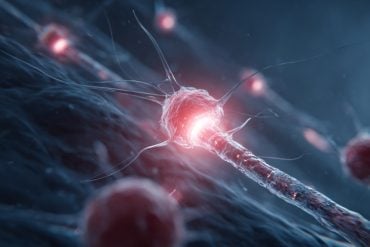Summary: Amyloid-beta accumulates in nerve cells and spreads, from cell to cell, via nerve fibers. This process occurs prior to the formation of amyloid plaques in the brain.
Source: Lund University
An experimental study from Lund University in Sweden has revealed that the Alzheimer’s protein amyloid-beta accumulates inside nerve cells, and that the misfolded protein may then spread from cell to cell via nerve fibres. This happens at an earlier stage than the formation of amyloid-beta plaques in the brain, something that is associated with the progression of Alzheimer’s disease.
The study in question builds on previous research based on amyloid-beta’s prion-like properties. This means that the protein adopts a misfolded form that acts as a template for spreading in the brain, where it accumulates and develops plaques.
“The plaques of amyloid-beta outside the nerve cells have long been a target for treatment of Alzheimer’s disease. But as treatments to remove plaque have not helped against dementia, we must develop and investigate other hypotheses in order to find other targets for treatment. Our results indicate that amyloid-beta is highly relevant, but that we must focus on misfolded amyloid-beta inside the nerve cells that arise far earlier than the visible plaques”, says the first author of the study Tomas Roos, doctoral student at Lund University and resident physician at Skåne University Hospital’s neurological clinic.
Amyloid-beta is present in the brain of healthy individuals, but the mechanisms that are disrupted and cause the misfolding remain unclear. The plaques are extracellular, but the results of this study indicate that a misfolding can occur within the cells.
Furthermore, the researchers show that there is a continuous exchange of amyloid-beta between the outside and inside of nerve cells, a kind of equilibrium, that is disturbed when misfolded amyloid-beta accumulates both inside and outside nerve cells.

In the study, which was conducted using a mouse model for Alzheimer’s and cell culture, the researchers also noted that misfolded amyloid-beta inside the nerve cells leads to increased amyloid-beta production.
“The increased amyloid-beta caused by misfolded amyloid-beta inside cells can bring about a vicious circle of more and more amyloid-beta production. This could explain the enormous amounts of amyloid-beta that accumulate in the brain of Alzheimer’s patients.
“First and foremost, the study results are to be replicated in a different Alzheimer’s model. However, our results indicate that many of amyloid-beta’s damaging effects may be caused by what is happening within the cells, independent of plaques. This may explain why so many experimental treatments targeting plaques outside the nerve cells have failed and that we should focus our attention inwards,” concludes Tomas Roos.
About this Alzheimer’s disease research news
Author: Lotte Billing
Source: Lund University
Contact: Lotte Billing – Lund University
Image: The image is in the public domain
Original Research: Open access.
“Neuronal spreading and plaque induction of intracellular Aβ and its disruption of Aβ homeostasis” by Tomas Roos et al. Acta Neuropathologica
Abstract
Neuronal spreading and plaque induction of intracellular Aβ and its disruption of Aβ homeostasis
The amyloid-beta peptide (Aβ) is thought to have prion-like properties promoting its spread throughout the brain in Alzheimer’s disease (AD). However, the cellular mechanism(s) of this spread remains unclear. Here, we show an important role of intracellular Aβ in its prion-like spread. We demonstrate that an intracellular source of Aβ can induce amyloid plaques in vivo via hippocampal injection.
We show that hippocampal injection of mouse AD brain homogenate not only induces plaques, but also damages interneurons and affects intracellular Aβ levels in synaptically connected brain areas, paralleling cellular changes seen in AD. Furthermore, in a primary neuron AD model, exposure of picomolar amounts of brain-derived Aβ leads to an apparent redistribution of Aβ from soma to processes and dystrophic neurites. We also observe that such neuritic dystrophies associate with plaque formation in AD-transgenic mice.
Finally, using cellular models, we propose a mechanism for how intracellular accumulation of Aβ disturbs homeostatic control of Aβ levels and can contribute to the up to 10,000-fold increase of Aβ in the AD brain.
Our data indicate an essential role for intracellular prion-like Aβ and its synaptic spread in the pathogenesis of AD.






